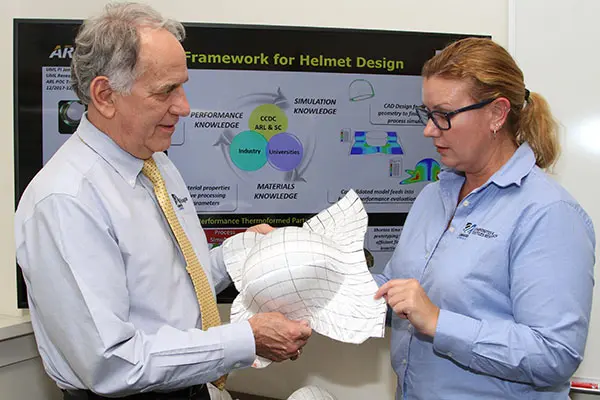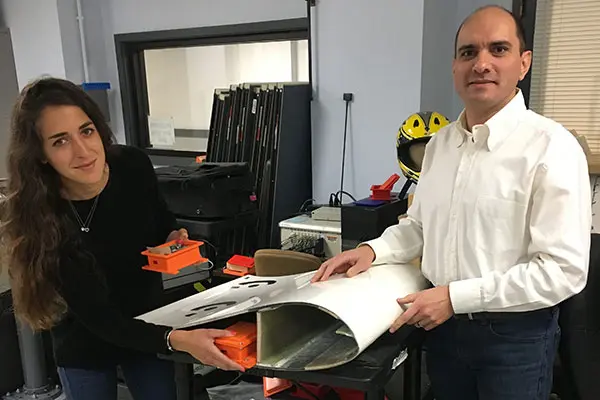Studies Are Supported by Grants from U.S. Army Research Centers

10/07/2019
By Edwin L. Aguirre
Keeping American infantry soldiers safe and protected in the field is a top priority of the U.S. military. And a vital part of this protection is the combat helmet.
The U.S. Army first began issuing steel helmets in 1917, when ground troops fought in World War I in Europe. But their thin walls offered soldiers little protection against gunfire from rifles or machine guns.
Over the next century, the helmet evolved in design and materials. A brimless, full-dome steel version that provided increased protection against shrapnel was used in World War II, the Korean War and the Vietnam War. In the 1980s, the headgear was modernized with the introduction of Kevlar, a new lightweight ballistic material made by DuPont that can stop bullets fired from pistols. The military continues to look for improvements in the design, efficiency and cost-effectiveness of the helmet manufacturing process, while making the headgear even safer and more reliable.
Among the researchers at the forefront of this effort are two engineering teams from UMass Lowell led by Prof. James Sherwood and Asst. Prof. Murat Inalpolat, both of the Department of Mechanical Engineering.
“Murat and I are both looking into how to better protect soldiers from serious head injuries,” says Sherwood, who is the interim dean of the Francis College of Engineering.
“The difference between our projects is that I am working on the design for the manufacturing of the helmet. Murat is working on how the selection of foam materials and their placement inside the helmet can mitigate the shock wave that results from a high-velocity impact that could cause traumatic brain injury,” explains Sherwood. “My goal is to keep the bullet from penetrating the shell of the helmet. Murat is looking at how to dissipate the shock wave’s energy before it induces concussion.”
Sherwood’s project is funded with a three-year grant worth nearly $600,000 from the U.S. Army Research Laboratory (ARL) in Aberdeen, Md.
Inalpolat’s study is supported by a two-year grant totaling more than $519,000 from the U.S. Army Combat Capabilities Development Command (CCDC) Soldier Center in Natick, Mass.
Balancing Act
According to Sherwood, the manufacturing of a combat helmet starts with 50 or more flat sheets of textile-reinforced composite material arranged in layers with alternating zero-degree and 90-degree orientation to form a laminate. The heated laminate is draped over a helmet mold and pressed tightly to make a preform. Three or more of these preforms are then stacked and squeezed together to make the final helmet.
“One of the biggest challenges is forming this stack — and there could be 150 to 200 sheets of the material consolidated together — into the hemispherical shape of the helmet without producing wrinkles, which could become sites of structural weakness,” he says. “The layers could separate, producing air gaps that would weaken the laminate and compromise the helmet’s integrity and safety protection.”
One way to minimize wrinkling is to pull on the ply material evenly to make it smooth as it is being wrapped and pressed on the helmet mold.
“You could apply in-plane tension to reduce the potential for wrinkling, but there is a delicate balance — if you pull too hard, the material is going to tear,” says Sherwood. “This is the reason why we need to characterize the behavior of the material’s deformation to determine how to mitigate, or even eliminate, wrinkles in the sheet without damaging it.”
Another challenge in helmet forming, he says, is how to keep the laminate’s thickness uniform. “As you stretch a sheet of material, it becomes thinner in some areas and thicker in other parts of the helmet. So, when you stack the layers on top of one another, they are not all the same thickness and you could have air gaps in between the laminates that could cause structural weakness.”
The way to compensate for this, Sherwood says, is to cut holes in areas where the layers are thicker so that “when we put these 150 to 200 layers together, we get uniform thickness across the surface.”

Assisting Sherwood in the lab are mechanical engineering Ph.D. students Kari White and Blake Campshure.
Sherwood points out that his team doesn’t actually make the raw ply material. “An outside company fabricates that,” he says. “Our role is to run the finite-element manufacturing simulation to see if the laminate would work, based on the design specs created by CAD engineers at the Army Research Lab. Then another ARL team would do the ballistic impact tests. So, we have three separate groups working together on the helmet-forming process.”
He adds, “Based on the helmet-forming study that we did in 2012 with the CCDC Soldier Center, researchers in Natick are already using some of our modeling techniques and are taking advantage of them.”
A New Decision-making Framework
Inalpolat says his project will help identify the most critical design parameters in creating the next generation of combat helmets, and thus provide soldiers with superior protection to avoid or mitigate traumatic brain injury, or TBI. This type of brain damage usually results from a violent blow or jolt to the head due to explosion from artillery fire or a roadside bomb.
Inalpolat’s team will combine data from actual and simulated impact tests to maximize the helmet’s energy-absorption capability. It will also develop a new decision-making framework for military planners based on data analytics for selecting a helmet that provides the highest performance in mitigating varying degrees of TBI.
“This framework will be based on novel machine-learning algorithms that will use the results of prior helmet impact tests along with advanced, finite-element modeling,” says Inalpolat, who is the principal investigator for the project.
The project will evaluate the current helmet systems available to soldiers against a wide variety of field conditions. “Our goal is to identify the characteristics that make for a superior protective system. This project will help the CCDC Soldier Center to steer away from the existing ad-hoc helmet design principles to a more data-driven decision-making framework to enhance and accelerate future helmet design and manufacturing processes,” he says.
According to Inalpolat, his team’s approach would not only maximize the helmet’s energy absorption, but it could also minimize the weight and stress/strain on the helmet components, thereby extending the helmet’s durability and service life. These advancements could lead to improvements in helmet protection that also would benefit athletes, public safety personnel and others.
“Our approach can also be used to improve helmets used in sports such as football, baseball, hockey, lacrosse, car racing and cycling, as well as other applications, including body armors for law enforcement,” he says.
Inalpolat’s team includes Mechanical Engineering Asst. Prof. Scott Stapleton as co-principal investigator and Baseball Research Center Asst. Director Patrick Drane as senior staff member. They are assisted in the lab by Inalpolat’s mechanical engineering Ph.D. students, Jaclyn Solimine and Bahadir Sarikaya.
Collaborating with them on the research are Corsair Innovations, a Plymouth-based company that manufactures advanced fiber energy-absorbing materials, and Ceradyne Inc., a subsidiary of 3M that produces advanced ceramic systems and components.
